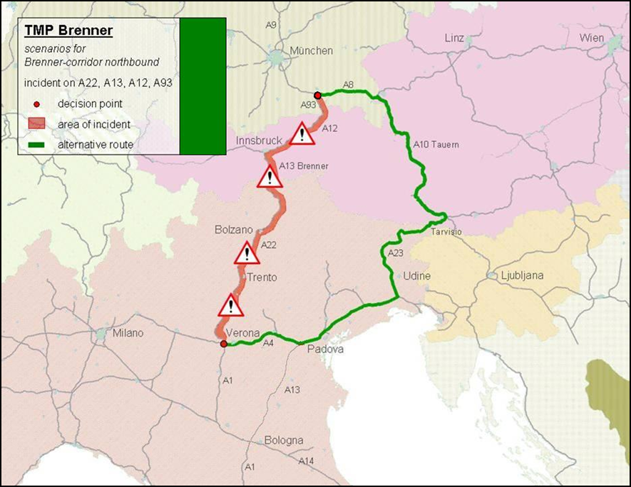| GENERAL INFORMATION | |
| Name of service/system/project | TMP Brenner Corridor (Austria, Germany, Italy) |
| Name of operator/organisation | Autostrada del Brennero (I) / Asfinag (A) / Bavarian Ministry of Interior (D) |
| Service delivery | ☒ Public
☐ Private |
| Mainly applicable Deployment Guideline |
ITS-DG-2015_TMS-DG07_TrafficManagementPlanForCorridorsandNetworks |
| Other relevant Deployment Guideline(s) |
|
| Contact for more information | ilaria.debiasi@autobrennero.it |
| GEOGRAPHICAL ASPECTS | |
| Country | Germany / Austria / Italy |
| Region of implementation | |
| Corridor(s) or Network(s) concerned | A 93 and A8 (Bavaria) / A13/A12 and A10/A2 (Austria) / A22 and A23/A4 (Italy) |
| ITS SERVICE DESCRIPTION | |
| General Objectives | ☒ Reduction of congestion
☒ Increase of safety ☐ Reduction of environmental damage ☐ Protection of the road infrastructure ☒ Increase traveller comfort ☐ Other: _______________________________________________ |
| Specific Objectives | ☐ Change the distribution in time of transport in order to achieve a more even allocation, avoiding peaks (access restrictions, fees)
☒ Change the distribution of transport in space in order to achieve a more even distribution on the network, and prevent “wrong vehicles on wrong places” (traffic control, traffic management, traffic information, access restrictions) ☐ Change the composition of vehicles on a certain piece of infrastructure (access restrictions, fees) ☐ Manage the flow on a given road section in order to reduce speed variation and thus improve the capacity and reduce the risk of incidents ☐ Manage access to a given road section in order to prevent disturbances and reduce the risk of incidents (e.g. ramp metering) ☐ Increase the speed on the link and thus increase capacity (throughput) ☒ Reduce the risk of incidents and traffic disruptions through better informed infrastructure users (traffic and traveller information) ☒ Reduce the consequences from disruptions through fast countermeasures (incident response time) ☐ Reduce traffic volumes through redistributing transport between transport modes ☐ Other: ______________________________________________ |
| Short narrative description of your best practice including e.g. geographical dimension, numbers, target group like HGV or passengers, costs etc. | The TMP for the Brenner Corridor just involves the corridor southbound and in particular different motorway stretches in Germany, Austria and Italy. The motorways involved in the main route or Brenner route (Inntaldreieck – Verona via Innsbruck) are the A93 in Germany, the A12 and the A13 in Austria and the A22 in Italy. The motorways involved in the alternative route or Tarvisio route (Inntaldreieck – Verona via Tarvisio) are the A8 in Germany, the A1, A10 and A2 in Austria and the A23 and A4 in Italy.
The main route is 362 km long, whereas the alternative route is 618 km long. The average travel time on the main route is 4,5 hours for HGVs and 3 hours for passenger cars. All motorways are two-lane motorways with a maximum capacity of approximately 3.000 vehicles per hour. The target group of the project are HGV drivers. |
| Relation with national access point set up according to EC Delegated Regulations | ☐ Provide information to the national access point
☐ Receive information from the national access point ☒ No connection to the national access point |
| Information provision to end users | ☒ Web portal
☒ Phone app ☒ VMS ☐ In-vehicle information ☒ Other; please specify: radio, RDS-TMC, television |
| IMPLEMENTATION ASPECTS | |
| Year of implementation
(+ end date of measure if applicable) |
2006 |
| Technical description | The Traffic Management Plan is activated in case of accidents, bad weather conditions, road works or HGV restrictions occurring anywhere along the Corridor A93 – A12 – A13 – A22). Different scenarios have been identified varying according to the spatial application of the event (critical event on the German, Austrian or Italian motorway network). Thresholds for the activation have been also set in order to identify the events to be considered to impact on the neighbouring networks: thresholds can refer to the length of a traffic block, to the duration of a road closure or to the type of weather event occurring. According to the event occurring and to the impact that this event might have on traffic and users safety the associated measure can vary from simple “information” or to “information and re-routing advice”. Once an event occurs on a network, the road operators of the neighbouring networks have to be informed. The latter must officially confirm the decision taken by the road operator on whose network the event occurs and the TMP can be activated. The same procedure has to be applied in case of deactivation of the measure. |
| Lessons learnt / factor of success / topics considered as good practice
(technical, legal, organisational, financial) |
The measure hasn’t been activated many times so far. The few times where it has been applied it was due to heavy snowfalls or to important road works at cross-border level (or near the border) and implied just information at cross-border level. The information flow worked well in both cases. The fact of having a defined protocol and to have identified the right person / TCC to contact surely eases communication between operators and reduces the intervention times in case of emergency. |
| Impacts assessment / results (if available) | |
| ILLUSTRATIONS |
 |
| Traffic Control and Management Centre of Autostrada del Brennero
|
| REFERENCES | |
| Documentation available on the project | § Memorandum of Understanding
§ Verkehrsmanagementplan für die Korridore Brenner und Tauern (Fortschreibung des CORVETTE Traffic-Managementplanes Brenner für die Fahrtrichtung Süden) |
| Web link | none |
